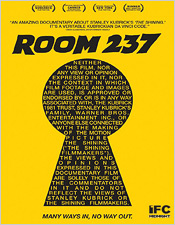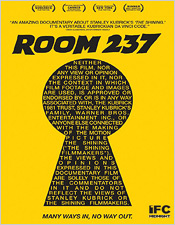Room 237 (Blu-ray Review)

Director
Rodney AscherRelease Date(s)
2013 (September 24, 2013)Studio(s)
IFC Films (MPI Media Group)- Film/Program Grade: D+
- Video Grade: C
- Audio Grade: C
- Extras Grade: C+
Review
While watching IFC Films’ Room 237, I was reminded of a line from The Big Lebowski: “This is a very complicated case, Maude. You know, a lotta ins, lotta outs, lotta what-have-yous. Lotta strands in old Duder’s head. Luckily, I’m adhering to a pretty strict drug regimen to keep my mind limber...”
This is a weird film. Honestly, I have no idea why it’s been released on Blu-ray Disc. At its best, Room 237 is the conspiracy-laden manifesto of a group of seriously-neurotic Stanley Kubrick fans. At its worst, this documentary is no different than any pretentiously cobbled-together diatribe you might find on YouTube. In fact, if you’ve ever watched one of Red Letter Media’s feature-length dissections of a Star Wars or Star Trek movie, this is sort of like that… only without all the laughs and entertainment value.
That’s a shame, because the strange Internet-charged world of extreme cinephilia is well worth thoughtful and thorough examination. But that’s not what you get here. Even were Room 237 simply an amusing celebration of the weird, along the lines of the entertaining Six Days in Roswell, I’d call it 102 minutes well spent. As it is, the documentary consists entirely of the audio ramblings of five obsessive fans of Stanley Kubrick’s 1980 film The Shining (Geoffrey Cocks, Juli Kearns, John Fell Ryan, Jay Weidner and – depressingly – veteran ABC News correspondent Bill Blakemore) as, one after another, they attempt to explain their esoteric theories about the hidden meanings and messages they’re convinced that Kubrick, in an act of pure genius, wove into the film for them to find. For Blakemore, the film is really about the genocide of the American Indians. Cocks, on the other hand, sees clear references to the Holocaust. But for Weidner, The Shining is nothing less than Stanley’s secret confession for having helped NASA fake the Apollo Moon landings. At every step, these ramblings are illustrated by patchwork footage taken from movies, documentaries, TV shows and whatever other video sources the filmmakers could find online, some of it related to Kubrick and some of it just convenient. Room 237 is the kind of film that should be fun, but all too quickly feels overlong and depressing instead.
The Blu-ray from IFC Films and MPI Media Group includes the film in HD video with lossless audio, but none of it really improves the viewing experience and much of the footage is either of low quality or is upconverted anyway. Extras on the disc include an audio commentary by Mstrmnd magazine editor Kevin McLeod (who has himself essayed voluminously on the subject of Kubrick and The Shining), 11 deleted scenes, a featurette on the music, discussion of the Mondo poster art, 2 trailers for the film and finally video of a Secrets of The Shining panel discussion held back in May at the First Annual Stanley Film Festival. Moderated by Badass Digest’s Devin Faraci, the panel runs about 50 minutes and is easily the most interesting thing on the whole disc, as it includes (among its participants) longtime Kubrick assistant Leon Vitali. My suggestion is just to sample the film and then skip right to the panel video. Or better yet, avoid this disc altogether and check out Wim Wenders’ superior 1982 documentary Room 666 (available in Anchor Bay’s 2004 Wim Wenders Collection DVD box set) instead.
Perhaps Stanley Kubrick’s true genius is that he’s created films that so deeply reflect the perceptions (and preconceptions) of his audience. In any case, as a fan of Kubrick myself, I was truly interested in seeing Room 237. And I managed to maintain that interest for about thirty minutes. After that, this documentary became a real slog. Room 237 is best watched with a group of fellow movie fans, MST3K-style, preferably while adhering to a pretty strict drug regimen. If nothing else, it’s proof of the scientific theory that the human brain has evolved to recognize patterns… even when they’re not actually there.
- Bill Hunt

